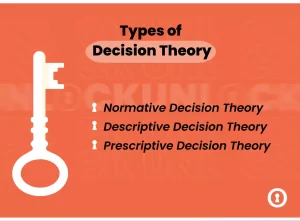Introduction
How can a person navigate the complexities of decision-making in daily life when confronted with countless decisions, ranging from simple choices to complex ones?
Have you ever experienced biases, uncertainties, and conflicting priorities clouding your judgment to make better decisions? Do you want to learn decision theory to improve the quality of your decision-making skills?
The ability to make informed decisions is a valuable skill that can be developed through practice and experience. Decisions shape reality and the outcomes you experience, from choosing what to have for breakfast to making important life-changing decisions. It involves considering various options and selecting the best course of action based on one’s goals and values.
It is important to note that decision-making is not always easy and can be influenced by various factors such as emotions, biases, and external pressures. Therefore, decision theory can help with decision-making skills that can lead to better outcomes and overall success in life.
In this blog, you will learn about decision theory. There are three types of decision theory. You will learn about all three types briefly in this blog. You will also see examples of decision theory. It is a field of study that helps individuals and organizations make informed choices. It involves analyzing different options and selecting the one that maximizes benefits or minimizes losses. By understanding it, you can make better decisions in your personal and professional life.
By the end of this blog, you will have a better understanding of decision theory and how it can be applied in various situations. Whether you are a student, a professional, or just someone interested in learning about decision-making, this blog will provide you with valuable insights and knowledge. So, let’s dive in and explore the world of decision theory!
What is Decision Theory?
Decision theory is a range of econometric and statistical tools for analyzing individuals’ choices. It is also known as the theory of choice, relying on beliefs, attitudes, and desires. It seeks to provide a framework for making rational choices in situations of uncertainty and risk. It has applications in various fields, including economics, business, political science, and healthcare. It is used to develop models that can help individuals and organizations make informed decisions based on available information and expected outcomes.
Types of Decision Theory
The three types of decision theory are:
Normative Decision Theory
Normative decision theory focuses on defining how decisions should be made to increase rationality and utility. It lays down principles, rules, and guidelines for optimal decision-making under uncertain or certain conditions. For example, in a business setting, normative decision theory can be used to determine the best course of action for investing in a new project. The theory would involve analyzing all potential outcomes and weighing the risks and benefits before making a decision that maximizes utility.
Descriptive Decision Theory
Descriptive decision theory seeks to understand how decisions are actually made in real life. It examines the cognitive processes, biases, and heuristics that individuals use when making decisions, providing insights into human behavior. For example, a study using descriptive decision theory found that individuals are more likely to choose an option with a known outcome rather than one with an unknown outcome, even if the unknown outcome has a potentially higher payoff. This insight can be applied in marketing and advertising to promote products or services with clear and tangible benefits.
Prescriptive Decision Theory
Prescriptive decision theory provides practical tools and techniques to improve decision-making. It offers strategies, methods, and frameworks that individuals and organizations can use to enhance the quality of their decisions. For example, prescriptive decision theory can be used in the field of healthcare to help doctors and nurses make more informed decisions about patient care.
By using decision-making frameworks and analytical tools, healthcare professionals can weigh the potential risks and benefits of different treatment options and choose the best course of action for each patient.
Also Read: Decision Making and Problem Solving Skills for Managers
Examples of Decision Theory
Decision theory is a branch of mathematics that helps individuals make rational choices in uncertain situations. It is widely used in economics, psychology, and political science to analyze human behavior and decision-making processes. However, this theory is not foolproof and can be subject to various biases, such as confirmation bias and the sunk cost fallacy.
For example, a person may stick with a failing investment simply because they have already invested significant time and money into it, even if all evidence suggests they should cut their losses and move on.
Also Read: How to Manage Your Manager: 15 Tips for Managing Your Manager| DT Evolve
Tips to Improve Decision-making Skills
Gathering Information
Well-informed decision-making needs relevant and reliable information. This information should be analyzed critically to identify any biases or inaccuracies. Seeking out multiple sources of information can help ensure a comprehensive understanding of the topic at hand. One way to gather information is through research, which involves examining various sources such as books, articles, and websites. It is important to critically evaluate the information gathered to ensure its accuracy and relevance to the decision being made.
Analyzing Risks and Uncertainty
Considering risk management and managing uncertainties is crucial in decision-making. This is particularly important in business, where failure to identify and mitigate risks can lead to significant financial losses and reputational damage. Risk management involves assessing potential threats, developing strategies to minimize their impact, and monitoring the situation closely to ensure that any necessary adjustments are made in a timely manner.
Evaluating Trade-offs
For example, choosing to spend money on a vacation means sacrificing the opportunity to save that money for a down payment on a house. These trade-offs can be difficult, but they are an inevitable part of decision-making.
Conclusion
In this blog, you learned about decision theory. There are three types of decision theory. You also learned about all three types briefly with examples of decision theory. It is a field of study that helps individuals and organizations make informed choices. It involves analyzing different options and selecting the one that maximizes benefits or minimizes losses. By understanding it, you can make better decisions in your personal and professional life.

















